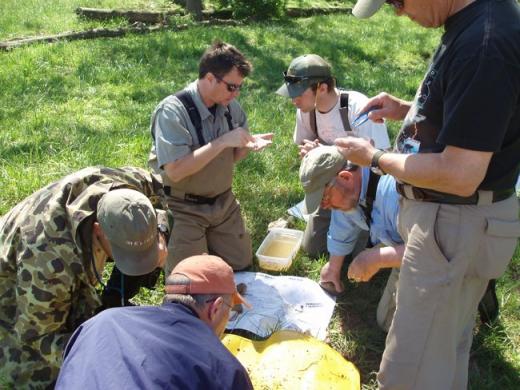
Community science is a rapidly expanding field where millions of participants each year gather data on hundreds of topics ranging from the weather, to water quality, threatened and endangered species, and such far off topics as the shape of galaxies. Trout Unlimited members have been gathering data on water quality and fish populations since the organization was established in 1959 but only recently have we expanded the opportunities for the public and actively marketed the potential for anglers and other community members to assist in the science-based management of trout and salmon and their habitats.
In 2016, TU scientists wrote a feature article in the Journal of Soil and Water Conservation about some of our larger Community Science projects and how participation among communities produces more knowledgeable advocates for better stewardship of coldwater fisheries resources.
As demonstrated in this Community Science video, TU’s grassroots members grow in strength and capacity when they partner with management agencies to help fill data gaps and improve our understanding of trout, salmon, and their habitats.
Check out the following opportunities for anglers and all members of the public to contribute to the scientific understanding of trout and salmon conservation.
RIVERS
The RIVERS mobile application is a convenient way for Trout Unlimited chapters to collect data on and map disturbances on their home waters while fishing or conducting a watershed inventory. This basic information is stored online and can be queried later on your phone or desktop computer to prioritize conservation projects, including having potential projects at your fingertips when funding opportunities arise. The information collected is intended to be a broad description of the disturbance with photographic evidence that is geolocated (eg, GPS location). More detailed follow-up surveys may be required as needed to determine project potential.
Stream Temperature Monitoring
Trout prefer cold water, often less than 65°F, and stream temperature has a strong influence on their well-being. TU restoration projects often target improving stream temperatures, and keeping a record of temperature variability and trends can be an important tool to help confirm the success of these efforts or identify where further work is needed. Waterproof data logging thermometers offer a simple, affordable means to fill this need. Check out our Stream Temperature Monitoring Handbook. TU also works closely with US Forest Service scientists and their NorWeST stream temperature network. Their website includes loads of suggestions for help in starting a stream temperature project and in interpreting results.
Culverts and Road Stream Crossing Assessments
Our objectives through assessing road stream crossing infrastructure are threefold: first to evaluate a stream’s aquatic organism passage, second to understand its geomorphic compatibility with restoration work, and lastly to evaluate its hydrologic vulnerability. Ultimately, our desire is to reconnect trout habitat and at the same time help communities become more “flood resilient”.
The New England Culvert Project (NECP) has been working with TU Chapters and state agencies across the northeast to field assess road stream crossings on a landscape scale. Large drainages, such as the Deerfield River in MA and VT and the Ammonoosuc and Piscataquog Rivers in NH, have been completely evaluated for the metrics mentioned above. This information is then shared throughout the watershed community in an effort to help towns, with assistance from the NECP team, proactively restore vulnerable infrastructure. The Piscataquog River project, encompassing 218 square miles, utilized over 800 hours of TU Chapter volunteer time to assess over 525 culverts. TU Chapter volunteers are trained, supplied with the necessary gear, and assisted in the field by TU National staff.
For more information on how to help create a project in your community, contact Colin Lawson of our Eastern Conservation Staff.
Environmental DNA
Environmental DNA, or eDNA, uses trace genetic material present in waterbodies to identify the presence or absence of different species locally. This new and innovative approach is accelerating the way streams and lakes are sampled to detect which species are present.
Water Quality Monitoring
TU staff and volunteers conduct water quality monitoring to take the vital signs of streams and rivers across the nation. TU has developed an introductory manual on water quality monitoring to help guide these efforts.
Redd Surveys
This handbook was created by Trout Unlimited with funding from the United States Forest Service CitSci Fund. Our intent is to encourage and support chapter and staff-led redd survey projects. Redd surveys are relatively easy to conduct, provide useful data to track trout reproduction and offer a fun community science opportunity for local volunteers. These data can be used to monitor the effectiveness of restoration projects, prioritize restoration and protection efforts and track spawning response to environmental and climate factors. In addition, volunteers who take part in redd surveys gain a deeper connection to their local streams and rivers, often walking unknown stretches of their favorite streams and observing trout spawning activities. The purpose of this handbook is to provide guidance on developing a new redd survey initiative including data collection protocols, study design, outreach and logistics.
River’s Calendar
Trout Unlimited, the University of Massachusetts and partners are developing the River’s Calendar, a community science program in which trout anglers record the seasonal timing of aquatic insect emergence, fish movements and riparian plant flowering while fishing. This is another TU Community Science project that works through the iNaturalist observation platform. You can follow the River’s Calendar project and participate through iNaturalist. This information will be translated into detailed calendars of hatches and other riparian life for each river studied – suitable for use by anglers and other river recreationists. This information will also form the basis for an objective, science-based examination of the phenology of streams – the timing of life cycles and how they are influenced by environmental and climate change.



